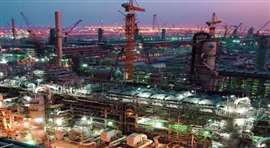Baker Hughes sees strong gas fundamentals, LNG momentum
April 23, 2025
CEO Lorenzo Simonelli also notes macroeconomic headwinds, including tariff concerns and reduced upstream investment
 Baker Hughes has booked $1.7 billion in LNG-related orders over the past two quarters and anticipates further growth, especially along the U.S. Gulf Coast where several customers are planning capacity expansions through 2030. (Image: Baker Hughes)
Baker Hughes has booked $1.7 billion in LNG-related orders over the past two quarters and anticipates further growth, especially along the U.S. Gulf Coast where several customers are planning capacity expansions through 2030. (Image: Baker Hughes)
Despite a cautious start to 2025 driven by geopolitical tensions, volatile trade policy, and a softening oil market, Baker Hughes is reporting continued strength in natural gas and LNG-related activity, particularly in long-cycle infrastructure and compression projects.
In a recent earnings call, CEO Lorenzo Simonelli pointed to macroeconomic headwinds, including tariff concerns and reduced upstream investment, while highlighting the company’s resilience through its gas-focused portfolio. “The global economy has started cautiously this year due to ongoing geopolitical tensions, uncertainty around trade policy and tariffs, China’s slower growth rate, and lingering inflationary pressures,” Simonelli said.
 Lorenzo Simonelli
Lorenzo Simonelli
He noted that Baker Hughes is proactively working to mitigate trade-related risks, especially around tariff exposure, through its international weighting, localized supply chains, and diversified operations.
Ahmed Mogul, CFO of Baker Hughes, elaborated on the company’s supply chain resilience. “We have a strong international mix in the company, and it’s not just from a customer perspective, but also from our global supply chain footprint. That naturally limits our exposure to direct US tariffs,” he said. “For context, we purchase roughly $14 billion in direct and indirect materials annually. Of that, we imported less than 5 percent into the US and under 2 percent comes from China. We’ve taken proactive steps to develop mitigation strategies, which help reduce the net impact of direct tariffs to the $100 million to $200 million range.”
He added that the company has formed a centralized coordination hub to monitor developments and respond quickly across supply chain, legal, commercial, and tax teams.
Softer outlook for oil, steady demand for gas
While oil prices remain volatile, natural gas continues to post a more stable demand outlook. Simonelli said Baker Hughes now expects global upstream spending to decline by high single digits in 2025, with North America facing a low double-digit drop and international markets down mid-to-high single digits.
Still, gas-linked infrastructure projects are advancing, with long-cycle LNG and compression investments moving forward. “Natural gas demonstrated the strongest increase in demand among fossil fuels in 2024,” Simonelli said, citing a 15 bcm increase in global demand, or 2.7 percent, driven largely by power generation. The International Energy Agency (IEA) confirmed this trend in its latest analysis.
LNG contracting and U.S. momentum
Simonelli noted that 15.5 MTPA of long-term LNG offtake contracts were signed in the first quarter of 2025, following a record 81 MTPA in 2024. He attributed this to consumer confidence in LNG as a long-term solution, adding that recent U.S. policy shifts have also helped.
“The repeal of the LNG permitting moratorium and the administration’s stated goal of increasing U.S. LNG exports has led to an improvement in orders for U.S. LNG projects,” Simonelli said. “Over the past two quarters, we secured $1.7 billion in LNG orders and that speaks to our leading position in LNG and reinforces the positive outlook for the year. We’ve got a growing number of LNG customers and we have supply agreements in place for over 120 MTPA of LNG.”
Baker Hughes has booked $1.7 billion in LNG-related orders over the past two quarters and anticipates further growth, especially along the U.S. Gulf Coast where several customers are planning capacity expansions through 2030.
Key orders in gas infrastructure and compression
The company is seeing growing opportunity in gas compression and pipeline infrastructure, driven by LNG expansion and rising demand from power-hungry data centers. Recent wins include two pipeline compression stations in North America, involving 10 gas turbines and 10 centrifugal compressors, as well as NovaLT turbine orders for data center microgrid projects.
 Moghal Ahmed
Moghal Ahmed
Baker Hughes also secured a liquefaction train order that includes four refrigerant compressors and four expander compressors powered by LM6000 turbines. Framework agreements with developers like NextDecade and Argent LNG could bring further equipment deals in the coming quarters.
In the UK, the company is supplying a NovaLT turbine and compressor for a gas boosting station tied to National Gas Transmission’s infrastructure investment.
Upgrades and aftermarket momentum
The company reported a record quarter for GasTech Services upgrades, up 67 percent year-over-year. Operators in the Middle East and North Africa are targeting efficiency and emissions improvements across compressor stations and gas processing plants.
Projects include turbine upgrades and new compressor trains at one of the world’s largest gas processing plants and a modernization initiative in Algeria in partnership with Sonatrach.
While the Oilfield Services & Equipment (OFSE) segment faces reduced upstream activity and greater exposure to macro volatility, the Industrial & Energy Technology (IET) division is providing stability through strong recurring revenue, a healthy equipment backlog, and expanding market reach.
“We remain confident in our strategy,” Simonelli said. “Our focus is on the areas within our control, driving productivity, executing with discipline and accelerating our efforts to be a leaner, more efficient company.”
The IET division booked $3.2 billion in orders in the first quarter, bringing its backlog to $30.4 billion. Adjusted EBITDA for the segment has grown at least 30 percent year-over-year for five straight quarters.
Data centers and future demand
Simonelli also highlighted the growing link between data centers and natural gas infrastructure. Baker Hughes booked 35 NovaLT gas turbines in the first quarter, 22 of which will power data centers. “Our focus is on the 150 megawatt range or below and that really suits well the NOVA gas turbines,” he said. “We’re continuing to increase the capacity of the NovaLT and we’re seeing good traction with our customers. Over the next three years, we expect to book at least $1.5 billion of orders in data center equipment. Long term, we think data centers could be a meaningful growth driver for IET as well as overall for the enterprise solutions we have and also recurring aftermarket services over the rest of the life of the equipment.”
In March, the company partnered with Frontier Infrastructure to deliver gas-fired power and CCS solutions for large-scale data hubs.
“This market segment, driven by AI and cloud services, is creating new demand for gas-fired generation and the supporting compression and emissions management technologies that we provide,” Simonelli said.
Baker Hughes sees natural gas and LNG continuing to play a critical role in global energy security and decarbonization. While oil market visibility remains limited, the gas sector’s long-term fundamentals, supported by infrastructure buildout and growing end-use markets, remain strong.
MAGAZINE
NEWSLETTER

CONNECT WITH THE TEAM







